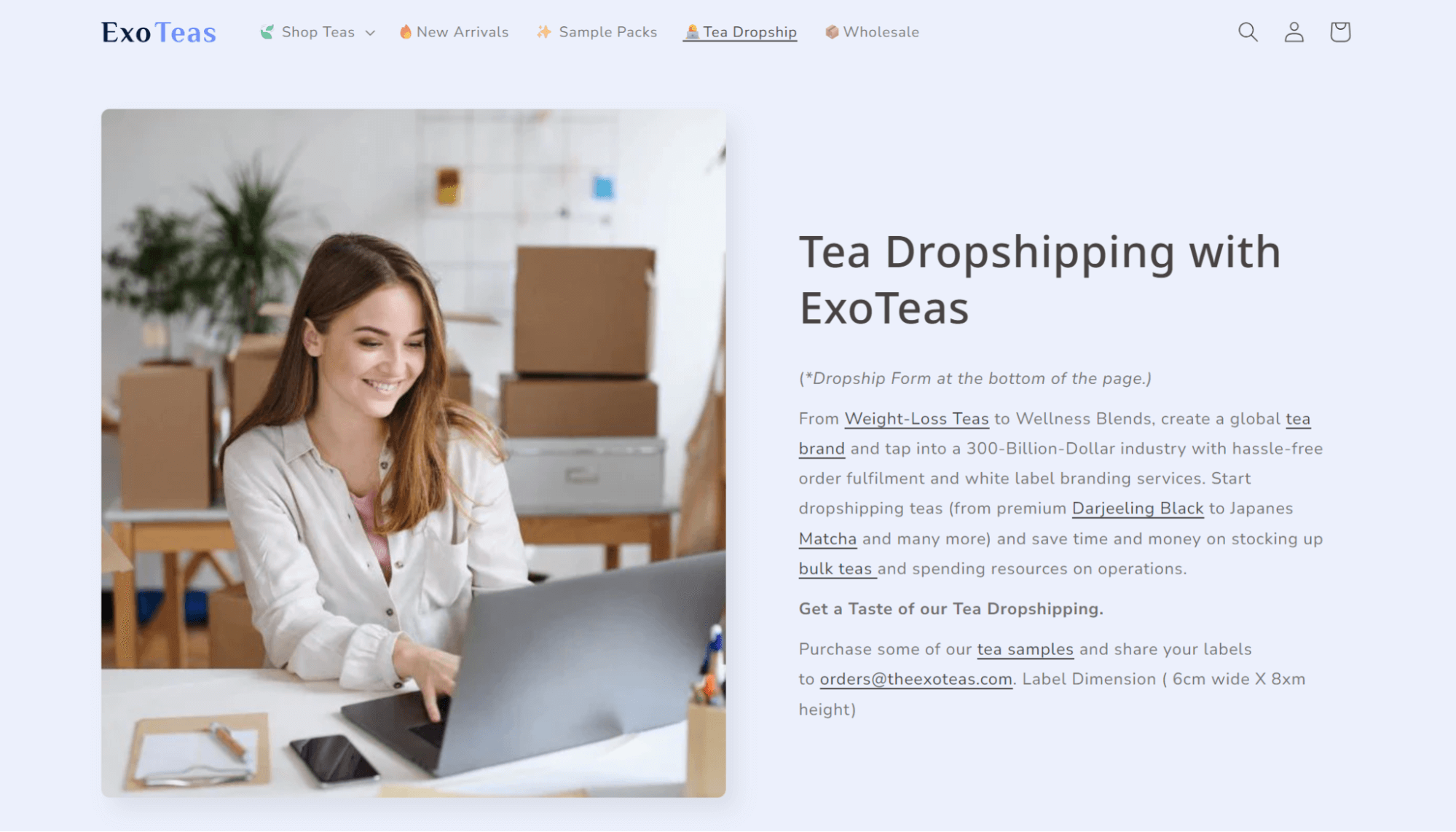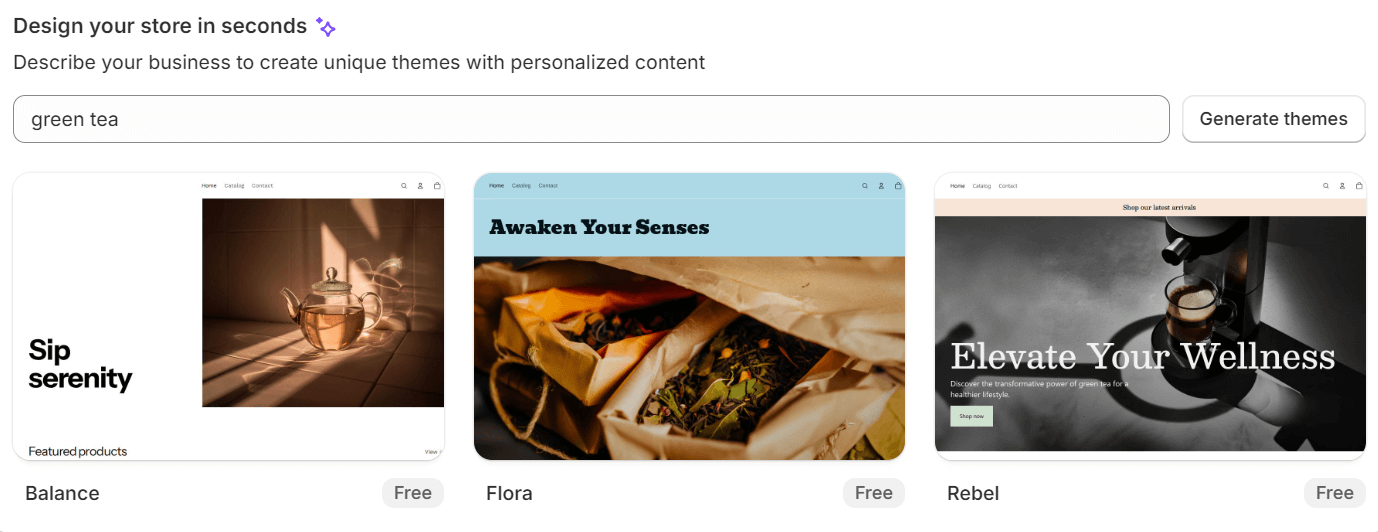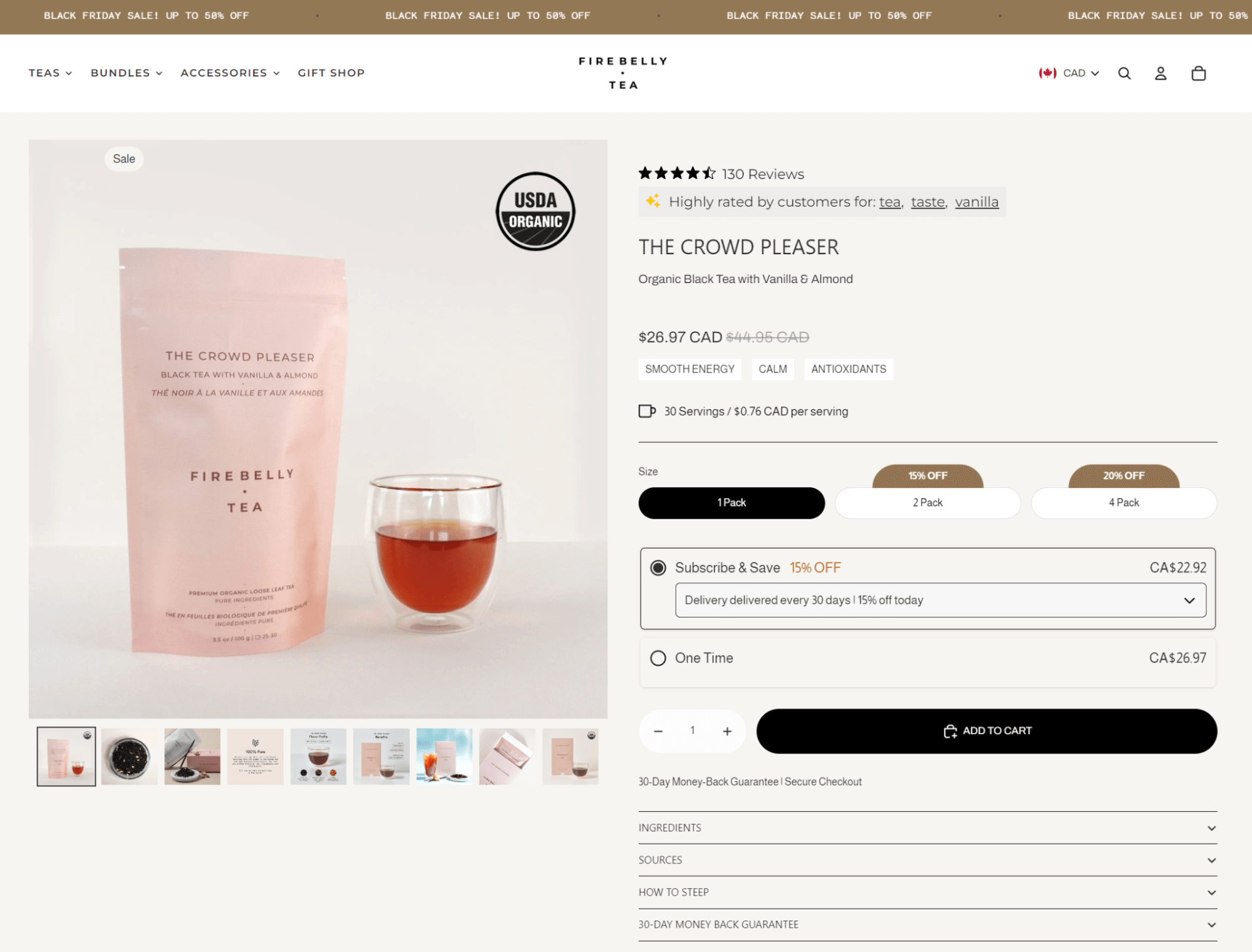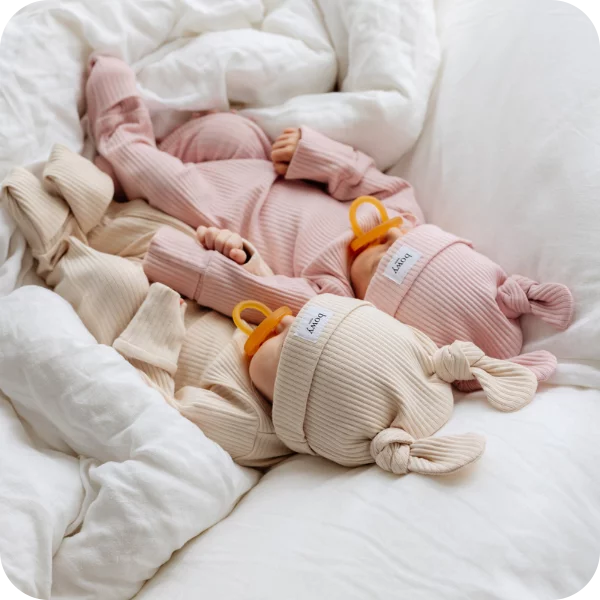Drive sales on autopilot with ecommerce-focused features
See FeaturesTea dropshipping allows you to create a branded storefront without the hassle of inventory management or fulfillment, making it a low-risk business model.
With high margins and the potential for repeat purchases through subscriptions, tea is an ideal consumable product for generating ongoing revenue.
Effective marketing strategies, including storytelling and email automation, can significantly enhance customer engagement and retention in your tea dropshipping business.
Choosing reliable suppliers and creating informative product pages are crucial steps to ensure a successful launch and operation of your tea dropshipping store.
With tea dropshipping, you can curate a branded storefront and build a unique customer experience without managing fulfilment or inventory.
Tea has high margins and low return rates, plus it’s consumable, letting you offer subscriptions and retain customers well beyond their initial purchase.
Another plus side to dropshipping tea is its marketing potential via email, SMS, and social media. New flavors, packaging, bundles, products, and competitions are just some of the ways to connect with customers.
This article is a practical guide to tea dropshipping, with insight into its potential, supplier selection, launching, marketing, and everything in between.
Quick sign up | No credit card required
What is tea dropshipping?
Tea dropshipping is an ecommerce model for selling tea without holding inventory or fulfilling orders, both of which you outsource to a supplier you trust.
Your dropshipping store makes the sale and processes the payment, then passes that information to your supplier, who gets paid upfront in most automated systems, or according to their payment terms, such as Net 30.
Dropshipping tea is admittedly very niche, but if you have a marketing strategy, reputable supplier, and high-quality customer experience, there’s every reason to think it could generate significant revenue and income for you.
Additional reading:
How to start dropshipping: 7 key steps for beginners (2025)
Why start a tea dropshipping business?
The global tea market was valued at $292 billion in 2025 (Statista), with customers searching for specialty blends and wellness teas they can’t find in stores. Your dropshipping business can supply what they’re looking for, and wellness trends work in your favor:
- People buy tea for relaxation, energy, digestion, and immunity support
- Tea drinkers develop habits and preferences
- Repeat purchases and subscriptions become natural extensions of customer behavior
Your startup costs stay minimal:
- No inventory to buy upfront
- No warehouse or fulfillment team
- Lightweight products keep shipping costs down
You’re looking at healthy margins on a consumable product that customers reorder. The main expenses include your ecommerce platform and payment processing fees, marketing, and brand building. Everything else gets handled by your supplier.
Top tea dropshipping suppliers to consider
Our pick of tea dropshipping suppliers includes options from the USA, Australia, China, and India, each with decent reviews:
GreenDropShip

Location: USA
GreenDropShip has 20,000+ natural and organic products (some are teas), integrates with Shopify, Amazon, and WooCommerce, and has no minimum order quantity. You can leave it to fulfill directly to customers, and it provides free Amazon FBA prep services.
Bondi Beach Tea Co

Location: Australia
Bondi Beach Tea Co. runs Australian-based dropshipping with no minimum orders. It handles label design from $31, printing from $0.30 per label, and ships directly to your customers. If you want to private label tea dropship, this supplier is for you.
ExoTeas

Location: India
ExoTeas handles everything from inventory storage to direct shipping from its Indian warehouse. Its service includes white-label packaging, 50+ tea varieties including Darjeeling and Matcha, and setup assistance for a $100 registration fee.
Yerba Mate

Location: China
Yerba Mate offers white label teas on Alibaba, which you can integrate into your ecommerce store with a dropshipping app. It has an excellent product selection, and they do wholesale if you intend to stock some products in the future.
How to launch your tea dropshipping store
You need a business plan to dropship tea, not just an ecommerce store and supplier to push fulfillment through. Follow these five steps to get started in the correct order:
1. Choose your niche and tea type
Off the tip of your tongue, you will probably name black and green varieties, fruit teas, matcha, and masala chai. A few more niche options include sencha, oolong, and flower teas, none of which most supermarkets stock.
Your niche is the market angle you choose, such as wellness teas, sleep aids, energy providers, gift sets, and rare imports. Some teas are known for wellness, sleep, and the like, or you can use passable marketing claims to imply benefits.
It’s impossible to know the legitimate demand for different tea types unless you can access the sales data for popular suppliers. However, you can use Ubersuggest for Google keyword research, and an Amazon FBA tool like Helium 10 for the same on Amazon.
2. Pick a reliable supplier
Reliable suppliers list their shipping and delivery times, provide itemized quotes, and have existing happy customers.
In any case, don’t take their word for it. Place test orders to assess their delivery times and product quality. If they are providing a custom packaging service, request a final quality sample, not a mock-up.
It’s best if your dropshipping supplier is located in your country, such as the US or UK, for optimal delivery times and communication.
The reality is that most tea dropshipping suppliers are in India and China. If you do pick an overseas supplier, you need fulfillment guarantees and a foolproof connection between your store and their system.
3. Set up your ecommerce platform
Ecommerce platforms have different monthly fees, plans, and payment processing charges to consider before building your store.
The most popular options:
- Shopify: Has a monthly plan from $39/month, includes web hosting, and provides the best app ecosystem for ecommerce and dropshipping features. Plus, its dashboard is the most intuitive for beginners:

- WooCommerce: Free with only payment processing fees, although you’ll need web hosting and plugins, which are less numerous than with Shopify.
The dropshipping app that creates the connection to your supplier is critical, or you can download or build an order forwarding system that sends your customers’ orders to your supplier. It isn’t feasible to manually send orders to your supplier if you have any volume.
Additional apps you’ll need include subscription and bundle builders, which let you package and sell teas to recurring and high-value customers.
That covers the basic setup for your backend, but the frontend is what encourages sales and provides your initial customer experience.
A few pointers for building your frontend:
- Pre-built premium themes with importable demo stores are the fastest way to launch a professional dropshipping store
- Free themes slash your setup costs, but won’t necessarily be updated regularly or provide an option for support if you need it
- Custom building a tea dropshipping store requires not only development experience but also insight into UX and building customer journeys
- Shopify has an AI theme builder, which could save you hours of design time:

4. Create product pages with strong copy + visuals
Your page design needs hierarchy with the product name and price visible immediately, followed by images, then descriptions and details below.
Place your add-to-cart button where thumbs naturally reach on mobile screens. Include trust signals like payment icons and shipping information near the buy button.
For example, tea retailer Fire Belly includes a 30-day money-back guarantee and secure checkout wording underneath its add to cart button:

For content, write descriptions that answer the questions buyers have while holding their wallets. What does it taste like? How many cups per package? What’s the caffeine level? Include brewing instructions with water temperature and timing.
Add origin details when they matter, plus any certifications and charitable initiatives that ensure a fair price for the harvesters.
Your images and videos will do the heavy lifting since buyers can’t smell or taste online. Show the tea leaves, the brewed color, and the packaging from multiple angles.
Once you have customers, you can request image reviews and add their lifestyle photos to your product pages to increase your tea dropshipping sales.
5. Launch email marketing flows
Email marketing generates revenue on autopilot once you configure the essential flows that handle customer interactions throughout their buying journey.
Start with these four sequences:
- Welcome series: A five to seven-day sequence for new subscribers. Email one delivers the discount code immediately. Email two showcases bestsellers after two days. Email three tells your sourcing story after another three days.
- Abandoned cart recovery: Three emails to recapture lost sales. The first sends within two hours, showing their selected items. The second follows at 12 hours, addressing shipping concerns or return questions, and the third deploys at 24 hours, offering 10% off if they still haven’t made a purchase.
- Order confirmations: These typically have the highest open rates among all other transactional messages. Include order details up top, then add suggested products below since everyone reads these.
- Post-purchase flows: Activate one to two weeks after delivery. Request reviews, suggest teas that pair with their purchase, or pitch subscription membership for monthly savings.
Omnisend offers pre-built flows for these, as well as additional flows for cross-sells, birthdays, product reviews, follow-ups, and more. You can keep your flows single-channel, or add SMS and push notifications for an omnichannel approach:

Its intuitive flow builder is complemented by an equally professional email builder with 250+ templates for all scenarios, from sales events to feedback requests.
Personalizing your templates with a customer’s name is as simple as using liquid templating for names, and you can add the personalized product recommendation item to show products based on previous engagement and orders.
 | Bowy Made generates 70% of revenue from email automations, particularly pre-purchase flows like browse and product abandonment. These sequences added five figures monthly without requiring constant campaign creation or discount-heavy messaging. Read the Omnisend customer story: Bowy Made. |
How to market your tea dropshipping store
These marketing tactics and channels will help you reach as many customers as possible:
- Use storytelling: Topics include tea origins, flavors, harvest timing, supplier information, charitable initiatives, packaging efforts, and any other aspect that your customers find interesting enough to influence their buying behavior.
- Offer sample packs: Instead of selling multiple teas in large quantity boxes, sell one box containing one of each tea variety and offer it at a discount. It’ll help your customers find their favorite products and lead to more sales as a result.
- Let customers build bundles: Promote your bundle builder across all your customer touchpoints to make tea buying a personal experience. Even if you only sell one tea type, your bundles could include teacups, pots, and other accessories. Your customers will do the marketing for you when they share their unique purchases.
- Get influencers on board: Tea influencers are few and far between, but that doesn’t matter when your niche could be health, energy, and vitality (all areas that your tea dropshipping business can target).
- Build email campaigns and automations: Campaigns are scheduled or one-time sends, while automations are sequences that trigger according to the conditions you set. You should use both to target customers at different moments.
Ready to start your tea dropshipping business?
You can dropship tea and become profitable within three to six months with our guide. Here’s a recap of the most crucial points:
- Brand positioning: Wellness seekers and gift shoppers buy for entirely different reasons. Pick who you’re talking to and build everything around their requirements.
- Quality suppliers: Test their shipping times yourself. Verify they have stock when they say they do. Check if their white-label packaging looks professional or just cheap.
- Working storefront: Shopify and WooCommerce both work fine. What matters is connecting to your supplier automatically and letting customers subscribe to monthly deliveries.
- Informational product pages: Answer every possible question about origin, brewing, caffeine, taste, and health benefits.
- Email automation: Omnisend automates emails that generate revenue, such as welcome series, cart recovery, and reorder reminders tailored to consumption patterns.
Quick sign up | No credit card required
Tea dropshipping FAQs
Yes, tea ships without breaking, it doesn’t expire quickly, and your customers might reorder monthly. You’re selling 50g packages that cost pennies to ship versus bulky items that eat into margins.
Not usually, unless you’re making health claims or selling into regulated markets. Your supplier handles food safety paperwork. You only need a business license and a sales tax permit (where applicable).
A $5 tea can sell for $15-20 online, and your customer lifetime value could reach $200+ within six months if you nail retention. Profit depends on your traffic costs and email game.
Setting up takes a week or two if you use templates, and your first sales will usually come within two weeks of launching. Scaling to $10K monthly could take more than 12 months, but it is definitely possible with consistent marketing and good suppliers.
TABLE OF CONTENTS
TABLE OF CONTENTS


No fluff, no spam, no corporate filler. Just a friendly letter, twice a month.

 OFFER
OFFER







